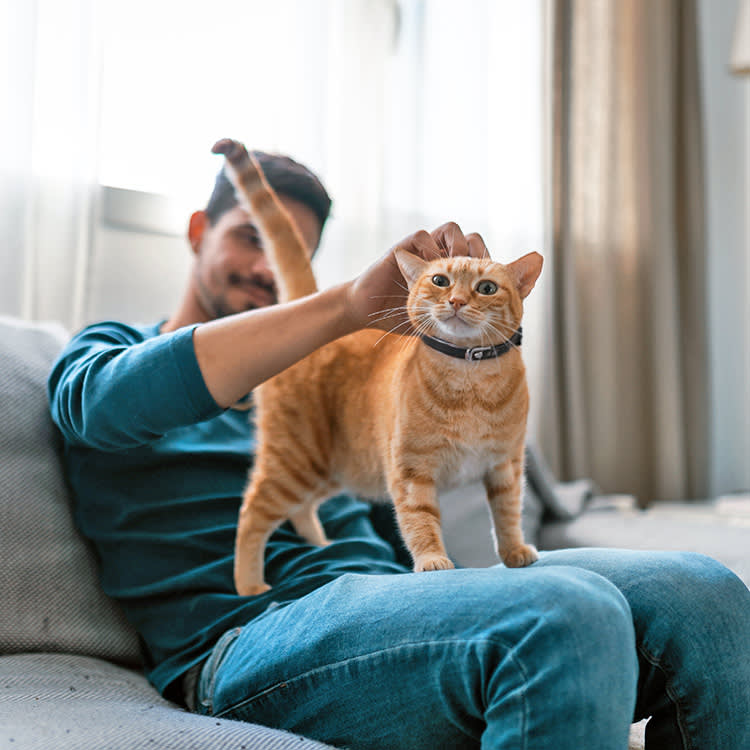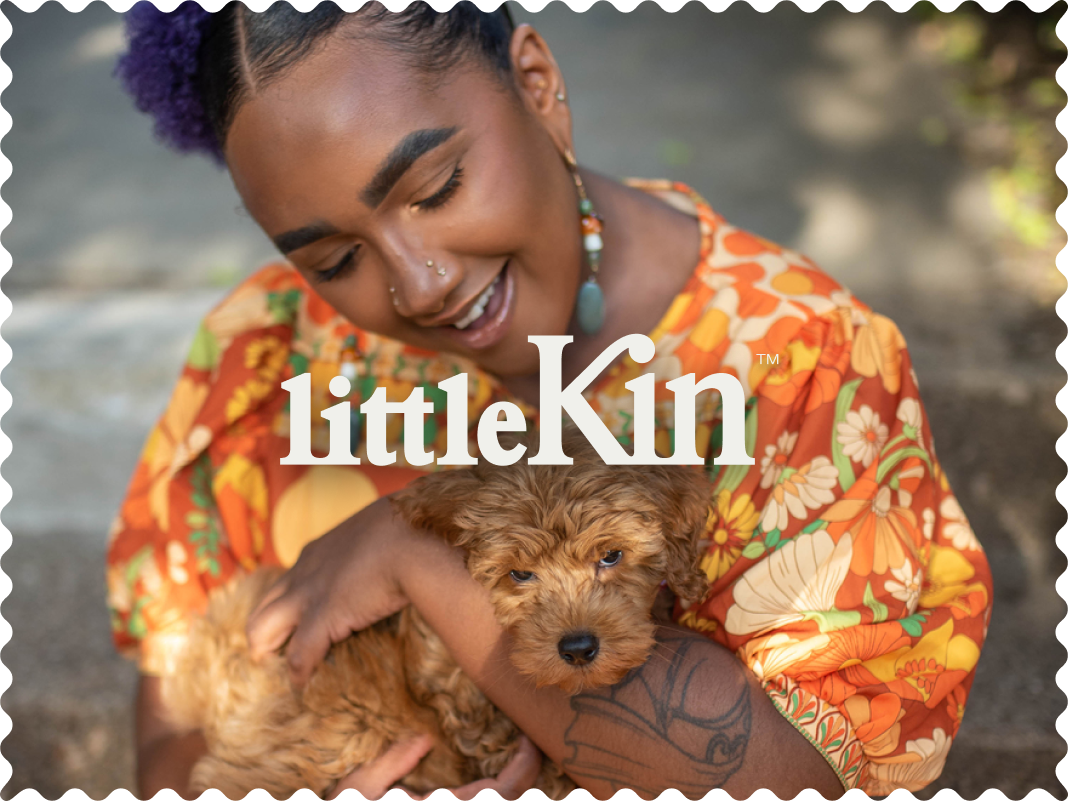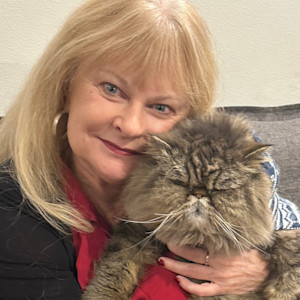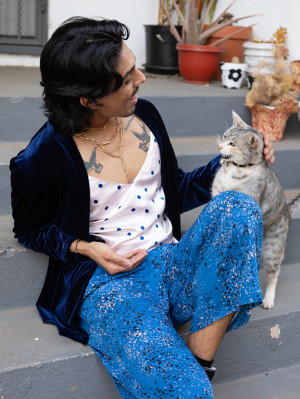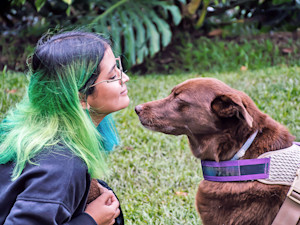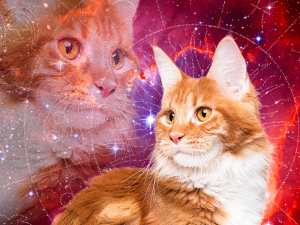How to Identify Cat Breeds: Traits, Apps, and DNA Testing
When it comes to this info, pet parents are as curious as.... you fill in the blank.
In This Article:
What Makes a Cat a Specific Breed? How to Identify Cat Breeds Apps and Technology That Can Help
Cats come in a variety of shapes and sizes. There are many breeds, but most cats are domestic mixed breeds (domestic shorthair or domestic longhair). However, numerous features help distinguish one breed from another: Cats can be sleek and angular, plush and round, tailless or tuft-tailed, and chatty or silent.
Pet parents seem to have a natural curiosity about their cat’s breed. To satisfy that curiosity, you can examine your cat’s physical traits and behavior, or use tools such as breed ID apps and DNA tests. The purpose of this guide is to give you some tips to help you identify your cat’s breeds and to detail the modern tools that can provide more details about their genetic background.
What makes a cat a specific breed?
What is the definition of a breed? It’s a population of cats with traits that came about through selective breeding and are predictable. Those traits are recorded in a registry. To be a specific breed, a cat must:
How much do you spend on your pet per year?
Have pedigree documentation, which is a traceable lineage registered with a known cat association
Conform to a breed standard which comprises physical and sometimes behavioral traits (for example, heavy bone and tufted ears are characteristic of Maine Coons)
Be reproducible, such as two registered-breed parents having offspring, who inherits their traits
Breed and appearance are not the same. You often see a cat who resembles a breed without being that breed. For example, a cat may look Siamese, but really be a color-point domestic shorthair without pedigree proof.
How to identify cat breeds
It’s not easy to determine your cat’s dominant breed just by looking at a single physical characteristic. However, if there are several similar characteristics, those will give you a stronger hint. Let’s look at the most common factors evaluated to determine a breed.
Coat type and color
Length
Shorthair: This is the most common type of cat coat. It is an inch or less in length.
Medium hair or longhair: The length of this haircoat is greater than an inch. There may be a ruff, britches, or tufted paws/ears.
Texture: Different breeds have coats that feel different. Siamese/Oriental cats tend to have silky and short coats, while British Shorthair/Scottish Fold coats are plush and dense.
Patterns and colors
Patterns can be tabby (mackerel, classic, spotted, or ticked), tortoiseshell, calico, bicolor, color point, smoke, shaded, or silver. Some combos will provide clues.
Color-point and blue eyes: Siamese family influence (but also Ragdoll, Birman, and Himalayan).
Shaded/silver: This may indicate Chinchilla lines.
Cinnamon/fawn: This is more common in Oriental groups.
Unique phenotypes
Hairless: This is a Sphynx-type
Curly: This often indicates Devon Rex/Cornish Rex/Selkirk Rex lineage.
Body shape and size
Oriental/foreign type: Tend to have a long, fine-boned, tubular body, long tail, and wedge head (such as Siamese/Oriental Shorthair)
Cobby body type: Stocky, round, heavy-boned, and short tail (like a Persian or British Shorthair)
Semi-foreign/semi-cobby: Balanced frames (American Shorthair, Ragdoll)
Large forest/working types: Characterized by their rectangular body, strong square muzzles, and lynx-like tips (such as Maine Coons) or by a triangular head, double coat, and substantial ruff (the Norwegian Forest Cat)
Eye color and shape
It would be hard to deny that cats have gorgeous eyes.
The shape: Almond or slanted (with an Oriental influence) or large/round (Persian/exotic)
The color: Can be blue with color points, copper/orange (common in some blue-coated British Shorthairs), and odd-eyed white cats (occurring in several breeds and domestic cats)
Ear shape and position
Large, high-set, wide-based: Oriental/Siamese types
Small, rounded, lower-set: Cobby types
Folded ears: requires pedigree context due to health implications (see Scottish Fold)
Ear furnishings/lynx tips: common in long-haired forest/working types, especially Maine Coons
Tail length and shape
Natural bob/short: Manx, Japanese/American Bobtails, also arising spontaneously in mixes
Plumed long tail: Typical of longhairs such as Ragdolls, Norwegian Forest Cats, Maine Coons
Kinks/curves: Occurring in regional populations
Personality and behavior clues
Just as you cannot rely on physical characteristics alone to identify a breed, behavior also may point to (but does not prove) a cat’s suspected lineage.
Siamese/Oriental tend to be vocal, people-focused, and high-energy.
If a cat is relaxed, floppy, and go-with-the-flow, we associate them with Ragdolls.
Maine Coon may be in their genes, if a kitty is inquisitive about water.opens in new tab
Apps and technology that can help with cat breed identification
Technology can be an excellent tool for helping confirm suspicions, but it doesn’t give you a definite verdict.
Breed identification apps
Computer vision apps analyze photos and offer likely breed matches, accompanied by confidence scores.
Pros: These apps are fast, fun, and good at singling out prominent features (hairless, folded ears, color-point, bobtail).
Cons: Lighting, angles, grooming length, and the high prevalence of mixed-breed cats can lead to mixed results (for instance, these apps may categorize any color-point as a Siamese).
Here are some best practices to consider when using these apps.
Upload multiple clear photos that include your cat’s front face, side profile, whole body, tail, and a coat close-up.
Re-run photos taken in neutral lighting and different seasons (to capture coat changes).
Use the top three to five candidates as a research list, then compare them to breed standards (see below).
Online breed databases
Utilize official breed standards and galleries.
CFA and TICA publish detailed standards with drawings and allowed colors/patterns.
Breed clubs offer photo galleries, FAQs, and subtle differentiators (like Maine Coon vs. Norwegian Forest cat head/muzzle shapes, and Ragdoll vs. Birman paw patterns). Use these to confirm or refute what the apps suggest, focusing on trait clusters that align with one breed more than others.
Consult cat breeders and experts
Well-known, experienced breeders and breed-club mentors can interpret nuanced features from photos and videos.
Veterinarians are good at evaluating health-related features (brachycephaly, ear folds). They can advise if DNA testing can clarify feline ancestry as well as potential health risks.
Breed-specific rescues are often experienced, but still make educated guesses.
Genetic testing
Feline DNA tests provide the most objective data for non-pedigreed cats.
What DNA tests can tell you
Ancestry estimates
Trait genes, such as long/short hair, dilute-color-point tabby type, white spotting, bobtail mutations, and so on
Health insights, including screening for known heritable risksopens in new tab (like PKD1, historically in Persian lines), blood type, and certain carrier states
What DNA tests can’t guarantee
DNA gives probabilities based on the company’s data, so they can’t determine pedigree status. Only registrations will prove if a cat is “purebred.”
These tests will not provide perfect precision for rare lineages. For instance, if a dataset is limited for a niche breed, the ancestry may be generalized to a broader type of cat.
How to choose a test
Select companies with large feline reference panels, transparent methods, and comprehensive ancestry, traits, and health reporting.
Consider if you want extras. Some tests offer oral health microbiome testing and broad carrier screening.
Check the sample type (usually a cheek swab), the expected turnaround time, and the privacy policies.
Use the results to complement a visual/behavioral assessment, but not to replace common-sense trait interpretation.
Bottom line
First, note the physical traits: coat length/texture, color/pattern, head/ear shape, eye color/shape, body build, tail, and standout features (such as folds, curls, hairlessness, or a bobtail). Compare these to official standards by using CFA/TICA and breed club resources to find the closest match.
Use apps to compare their results with yours. Verify against standards and photos from reputable sources. Seek the opinion of experts, such as breeders, breed clubs, experienced rescuers, and veterinarians, who can spot subtle signs of breed and discuss health implications.
Order a DNA test to gain clarity about your cat’s ancestry, genetic traits, and potential health risks. For many shelter-adopted cats, the most accurate description will be domestic shorthair or domestic longhair, with specific traits highlighted (such as “blue-eyed seal color-point DSH”).
FAQs
Can Google Lens identify cat breeds?
Google Lens can sometimes identify cat breeds by recognizing visual patterns and quickly surfacing look-alike images and breed names. It’s reasonably helpful with distinctive phenotypes (including hairless, folded ears, color point, and bobtail). However, Google Lens can overassign a breed label to common traits (such as any color point becoming “Siamese”). Use Google Lens to create a candidate list, then verify this against CFA/TICA standards and high-quality breed galleries. If the result matters (for health screening and such), follow up with a DNA test.
How can you determine the breed of your cat from a picture?
Take multiple photos in good, natural light, then run those images through a breed ID app to generate three to five candidates. Compare these to breed standards (CFA/TICA). Look for clusters: Does your cat match multiple hallmark features of one breed more than others? Also consider behavior (vocal vs. mellow, as well as social patterns) to support, rather than define, evidence. You can also order a DNA test to refine ancestry and genetic traits. Even with excellent photos, many cats are best described as domestic with breed-like traits rather than being a single, purebred breed.
How much is a DNA test for a cat?
Most feline DNA kits cost about $75 to $160, depending on the brand and features. Tests for ancestry-only or ancestry and basic traits are usually cheaper. Ancestry, traits, and comprehensive health screening typically cost more. Sales and bundles are also common, so check to see what’s included in these tests (such as the number of health conditions screened, depth of breed panel, trait breakdown, and turnaround time). If health insights (such as PKD1 status, blood type, carrier screening) could influence your cat’s care, opt for a kit that includes robust health panels and transparent veterinary-oriented reporting.
References
Keijser, S.F.A., et al. “Disease Burden in Four Populations of Dog and Cat Breeds Compared to Mixed-Breed Dogs and European Shorthair Cats.opens in new tab” Preventive Veterinary Medicine, vol. 140, May 2017, pp. 38–44
Lipinski, Monika J., et al. “The Ascent of Cat Breeds: Genetic Evaluations of Breeds and Worldwide Random-Bred Populations.”opens in new tab Genomics, vol. 91, no. 1, Jan. 2008, pp. 12–21,
Salonen, Milla, et al. “Breed Differences of Heritable Behaviour Traits in Cats.”opens in new tab Scientific Reports, vol. 9, no. 1, 28 May 2019, www.nature.com/articles/s41598-019-44324-x
